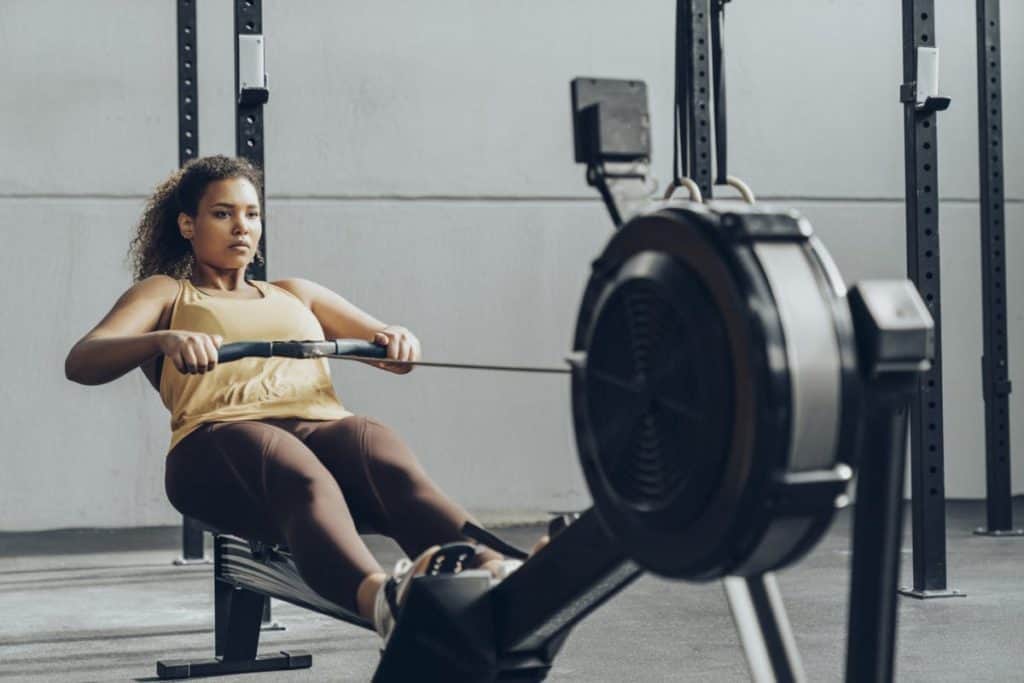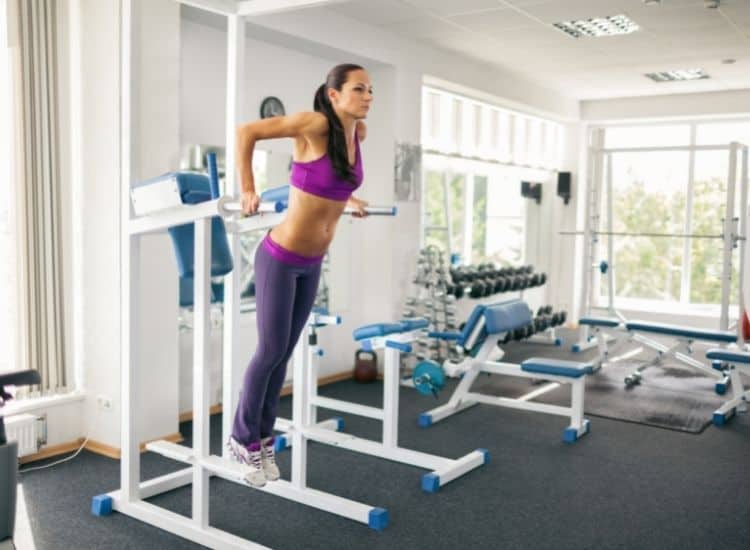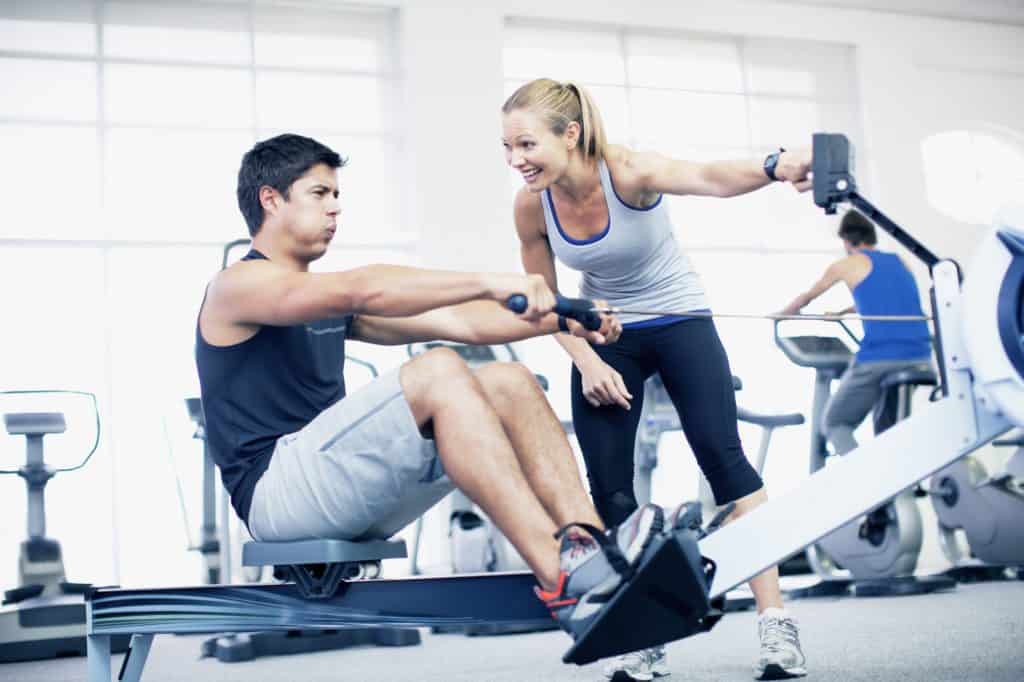If you’re looking to expand or start a home gym and you’re wondering which is going to be the best item of equipment between a power tower and a rowing machine — then we have all the information to help you decide.
Power Towers and Rowing Machines are two very different pieces of equipment, each with its own benefits, so which is best for you really depends on your exercise goals and the results you want to see.
In this article, we’ll take you through all the pros and cons of each kind of equipment and compare them head-to-head in various categories to help you choose which one will make it into your home gym.

What’s the Difference Between a Power Tower and a Rowing Machine?
Let’s start by taking a look at the key differences between the power tower and a rowing machine:
Purpose
When it comes to how each kind of equipment is used, the two are very different. The Power Tower is a static piece of equipment with various bars and grips that help perform calisthenics-type exercises and adds height and extra resistance to multiple moves.
The main aim of the power tower is to help users perform a range of exercises using body weight as resistance.
In contrast, the Rowing Machine is generally used for one purpose (rowing), and unlike the power tower, resistance can be increased to make a workout more intense.
Equipment
A basic power tower consists of three main sections built into a tall frame, each of which helps to perform various exercises at varying heights.
The top section of a power tower forms a pull-up bar which often includes wider grips so you can pull up with wide or narrow arms. The midsection usually has two small parallel arm grips; some have arm supports and backrest to help you hold a pose in certain moves. The base section has handles that allow the user to perform raised push-ups.
You can also attach equipment such as gymnastic rings or resistance bands to a power tower. Some more high-specification models come with these built-in, and some also come with a fold-down weight bench.
In contrast, a rowing machine is a fairly simple item of equipment used to replicate the kind of action you would perform if rowing on water.
A rower generally comprises a center bar with a sliding seat, a flywheel for power, a footrest, and a wide handle to perform the stroke.
There’s usually a computer display where you can increase or decrease resistance and track your performance, such as calories burned, time, distance, etc.
Exercises
The power tower mainly focuses on strength building, particularly in the upper body.
Here are some of the most common exercises that are performed using a power tower:
- Pull-Ups & Chin-Ups. Using the pull-up bar at the tower’s top section, you can perform a range of pull-ups and chin-ups, including regular and wide-arm, L-sits, and negative pull/chin-ups.
- Leg & Knee Raises. The mid-section of a power tower is perfect for leg and knee raises.
- Dips. The mid-section small parallel bars are excellent for performing dips and increasing upper body strength.
- Raised Push-Ups. The handles at the base section of a power tower are used to perform raised push-ups, increasing the strength-building potential you can get from the move.
In comparison, a rowing machine is predominantly used for rowing and helps users perform a cardio workout and build strength simultaneously. The intensity of a workout depends on how long you row and the level of resistance you use.
Some people use their rowers for non-rowing exercises such as raised push-ups or lunges using the sliding seat.

Pros & Cons Comparison
To help you decide which item of equipment is best for you between a power tower and a rowing machine, here are all the pros and cons of each one:
Power Tower Pros
The power tower can be a great way to work out at home, especially if you’re into calisthenics exercises such as pull-ups and dips. If you regularly workout using a power tower, you can expect to see many benefits, including:
- Improved Muscle Strength. The exercises performed on a power tower help increase muscle strength using body weight and are especially effective at strengthening the upper body, back, and core.
- Better Flexibility and Mobility. Bodyweight exercises are an excellent way to improve flexibility and mobility, enabling you to perform a wider range of moves.
- Improved Posture. Because the power tower is good for increasing upper body strength and the back, it can improve bad posture, which many people get from slouching or sitting for long periods. Improved posture also leads to greater stability and coordination.
- Allows You to Perform Calisthenics at Home. Calisthenics workouts are becoming increasingly popular, but some of the moves take a lot of time and practice to perfect. A power tower at home gives you instant access to the bars, which are often used for calisthenics workouts.
- Three-in-One. Although a power tower is tall, it doesn’t take up too much floor space and is equivalent to three pieces of equipment in one — a pull-up station, dip station, and push-up station.
- No Rules. The beauty of this exercise style is that there are no rules, so you can freestyle and create a workout that works for you and your goals.
Power Tower Cons
As well as the many benefits you can expect from a power tower, there are some cons that you might need to consider before deciding whether it’s the right piece of equipment for you:
- Requires Space. Although most power towers don’t take up too much floor space and can be pushed up to a wall when not in use, you need to consider the space you’ll need while exercising. Some exercises, such as leg lifts and L-sits, require more space around the tower.
- Not Recommended for Building Leg Strength. Most exercises performed on a power tower focus more on the upper body, meaning the legs don’t get much of a workout. If leg strength is important to you, there are ways you can incorporate more leg-based moves into a workout.
- Additional Cardio Required. An intense power tower workout will get the heart pumping, bringing a range of benefits, but not to the same level of repetitive cardio work such as rowing or running. Those who work on more strength-focused training often incorporate cardio workouts into their weekly exercise routine to gain greater cardio benefits.
- Requires Good Upper Body Strength. Many of the moves performed on a power tower (such as pull-ups and dips) need good upper body strength to lift your body weight. Although this is something you can build up to, it helps to have a degree of power already.
- Limited Opportunity to Build Muscle Mass. Bodyweight exercises are an excellent way to build muscle strength, and those who perform them regularly will likely see some amazing results. However, if building big muscle mass is your goal, you might be limited in how far you can go unless you include weight training in your routine.
Rowing Machine Pros
Rowers are known as cardio machines, and this alone comes with a string of health benefits, but there are a wider range of pros that come from owning one, including:
- Great for Cardio. One of the main reasons why people decide on rowing machines as their equipment of choice is the potential cardio benefits you can get through regular use. Cardio has many health benefits, including a healthier heart, greater lung capacity, and improved mental health.
- Provides a Full-Body Workout. When the stroke is performed correctly, a rowing machine helps to work the whole body, including the arms, legs, and core.
- Excellent for Beginners. The rowing machine requires a simple motion that can be performed by beginners or those who haven’t done this kind of exercise for a long time.
- Low Impact. Because most kinds of cardio activity are quite repetitive, some activities such as running can cause impact and stress to joints over time. Rowing machines are considered low-impact and can even help improve joint conditions by strengthening the muscles and connective tissues surrounding them.
- Extremely Versatile. Some people are put off rowing or other similar fixed exercise machines because they’re repetitive and can get boring if you do a long workout. To combat this, they use their rower for non-rowing activities because it works well to support or heighten certain exercises such as push-ups or lunges.

Rowing Machine Cons
Below are the main cons that require consideration before buying a rowing machine:
- Limited Opportunity to Build Muscle Mass. If you’re looking to build muscle mass through regular exercise, rowing alone might not be enough to achieve the goals you’re aiming for. Although rowing does help to build muscle strength, it will also help you appear leaner. If big muscles are your goal, you might consider incorporating additional weight training into your routine.
- Rowing Machines Can Get Boring. We touched on this in the pros section, but like many forms of cardio workout, the rowing machine can get repetitive because you’re mainly limited to one motion. To combat the boredom, listening to music or watching a tv show can help pass the time.
- They Can Get in the Way. Rowing machines are long, and although they don’t take up a huge amount of room, they can get in the way if your space is limited. Many people regret buying exercise machines if they’re in the way and they don’t use them much. Be sure that you’ll get the use out of a rower before you decide to buy!
- They Can Cause Lower Back Pain. Regular use of a rowing machine can cause lower back pain if you don’t hold the correct posture. The best way to avoid this potential problem is by holding in the abs to take the pressure off the back.
- Rowing Machines Can Be Noisy. Every rowing machine model is different, and some are noisier than others, but rowers are generally loud compared to other kinds of equipment. This might be something you need to consider if you live in an apartment or a shared house.
Power Tower vs Rowing Machine: Which to Choose?
If you’ve considered all the pros and cons of power towers and rowing machines but are still undecided, here is our head-to-head comparison to show which is the best in each category.
Best for Strength Building
Winner: Power Tower
When it comes to strength building, the power tower is the winner of the two because the equipment’s main aim is to perform exercises that focus on improving strength.
Rowing machines are also good for improving muscle strength in various body areas, but results will probably not be as good as you’d get with regular use of a power tower.
Best for Cardio
Winner: Rowing Machine
The winner of the best for cardio category has to be the rowing machine because this is the main purpose of this piece of equipment. With rowing, you’ll see improvements associated with regular cardio, especially if you increase resistance and workout length over time.
Best for a Home Gym
Winner: Power Tower
We’ve crowned the power tower winner in this category because of the range of exercises that can be performed on each station and the fact it takes up a little less floor space.
The power tower provides the opportunity to perform a greater range of moves, meaning you can do more with only one item of equipment.
Best for Beginners
Winner: Rowing Machine
Although beginners can use a power tower, they might be limited in the number of moves they can perform if they’ve not built up enough strength to hold their bodyweight through their hands and arms.
A rowing machine is easy for any beginner to get used to, providing posture is correct and they don’t overdo things, to begin with.
Best Value
Winner: Power Tower
The final category is best for value and the winner here is the power tower, based on the fact you can perform various exercises with only one piece of equipment.
You can pick up a cheaper power tower for $130 compared to a basic rowing machine which will cost around $200-$300. Ideally, to get the best quality equipment, you’d need to spend a little more.
Conclusion
The item of equipment that’s best for you all depends on your long-term goals and what you want to achieve from a regular exercise routine.
If cardio is important to you, then maybe a rowing machine would be better suited to your needs, but if you want to increase strength, you might want to go for a power tower.
The choice is yours — but we hope this article has been useful in helping you decide!

